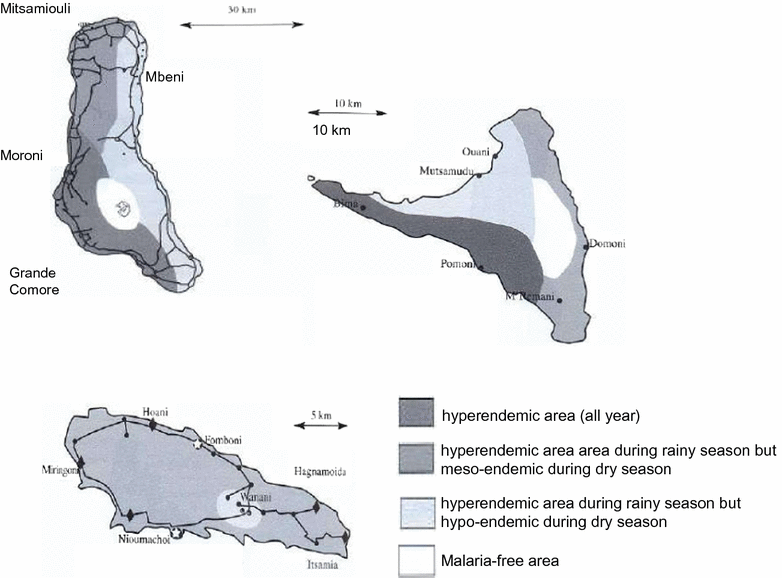Control of malaria in the Comoro Islands over the past century
- PMID: 28950864
- PMCID: PMC5615453
- DOI: 10.1186/s12936-017-2027-1
Control of malaria in the Comoro Islands over the past century
Abstract
Background: The Comoros are an archipelago located in the Indian Ocean between the eastern coasts of Africa and north of Madagascar. Malaria transmission appeared late in the 19th century due to the intensification of human migration. The story of malaria transmission for the past century is depicted to provide useful lessons for the future. Currently, malaria transmission occurs differently on each island; thus, control strategies must be adapted for each particular island. Tentative malaria control in Comoros has a long history of success and failure. This study reviews the data available as a basis for recommendations for the future.
Results: There has been much effort to reach a pre-eradication state in Anjouan and Moheli, but only control steps have been taken in the Great Comoro. To date, the primary strategy used is mass treatment of the population using artemisinin-based combination therapy (ACT), which is similar to the strategy deployed during the 1950s in other countries. ACT appears efficient in two of the three islands; however, the sustainability of the strategy is unknown. This sustainability is compromised by (i) the huge level of uncontrolled exchange between the Comoro Islands and their neighbours, increasing the risk of introducing ACT-resistant strains, (ii) the use of large quantities of pesticides for agriculture usually associated with the resistance of mosquitoes, and (iii) the cost of the actions themselves.
Conclusions: In view of the history of malaria in this area, the first recommendation is to enhance the training of health workers and the population. The second step is to establish a national strategy to assess malaria and related factors, which is currently lacking. A survey to assess the drug sensitivity of the parasites is particularly important in a context of low transmission associated with mass treatment of the population. The last point should be to secure financial support, which is not obvious in a context of pre-elimination. The Comoro Islands are thus a living laboratory to experiments with strategies for elimination, but the future is complex.
Keywords: Anopheles; Artemisinin; Chloroquine; Comoro Islands; Malaria.
Figures


Similar articles
-
[Malaria in the Comoros Archipelago in 2015: status after 15 years of fight].Bull Soc Pathol Exot. 2016 May;109(2):107-13. doi: 10.1007/s13149-016-0489-y. Epub 2016 Apr 21. Bull Soc Pathol Exot. 2016. PMID: 27160218 French.
-
[Epidemiology and prevention of malaria in the southwestern islands of the Indian Ocean].Med Trop (Mars). 2006 Jun;66(3):295-301. Med Trop (Mars). 2006. PMID: 16924826 Review. French.
-
[A survey of filariasis in the Comoro Islands, in Great Comoro and Mohéli].Bull Soc Pathol Exot Filiales. 1989 Jan;82(1):29-34. Bull Soc Pathol Exot Filiales. 1989. PMID: 2663209 French.
-
[Malaria in the islands of the Comoro archipelago. Historical and geophysical aspects. Epidemiologic considerations].Bull Soc Pathol Exot Filiales. 1988;81(5):847-53. Bull Soc Pathol Exot Filiales. 1988. PMID: 3071431 French.
-
[Combined antimalarial therapy using artemisinin].Parassitologia. 2004 Jun;46(1-2):85-7. Parassitologia. 2004. PMID: 15305693 Review. Italian.
Cited by
-
Effects of indoor residual spraying and outdoor larval control on Anopheles coluzzii from São Tomé and Príncipe, two islands with pre-eliminated malaria.Malar J. 2019 Dec 5;18(1):405. doi: 10.1186/s12936-019-3037-y. Malar J. 2019. PMID: 31806029 Free PMC article.
-
Large-scale Artemisinin-Piperaquine Mass Drug Administration With or Without Primaquine Dramatically Reduces Malaria in a Highly Endemic Region of Africa.Clin Infect Dis. 2018 Nov 13;67(11):1670-1676. doi: 10.1093/cid/ciy364. Clin Infect Dis. 2018. PMID: 29846536 Free PMC article.
-
The impact of targeted malaria elimination with mass drug administrations on falciparum malaria in Southeast Asia: A cluster randomised trial.PLoS Med. 2019 Feb 15;16(2):e1002745. doi: 10.1371/journal.pmed.1002745. eCollection 2019 Feb. PLoS Med. 2019. PMID: 30768615 Free PMC article. Clinical Trial.
-
Mass drug administration for malaria.Cochrane Database Syst Rev. 2021 Sep 29;9(9):CD008846. doi: 10.1002/14651858.CD008846.pub3. Cochrane Database Syst Rev. 2021. PMID: 34585740 Free PMC article.
-
Maternal Education, Fertility, and Child Survival in Comoros.Int J Environ Res Public Health. 2018 Dec 10;15(12):2814. doi: 10.3390/ijerph15122814. Int J Environ Res Public Health. 2018. PMID: 30544762 Free PMC article.
References
-
- Ouledi A, Toilibou A. Lutte contre les vecteurs du paludisme. Moroni: PNLP-Comores; 2012. A5.4.
-
- Mouchet J, Carnevale P, Coosemans M, Julvez J, Manguin S, Richard-Lenoble D, et al. Biodiversité du paludisme dans le monde. Paris: John Libbey Eurotext; 2004.
-
- Blanchy S, Benthein F, Sabatinelli G. Epidémiologie du paludisme en République fédérale Islamique des Comores. Cahiers ORSTOM. Série Entomologie Médicale et Parasitologie. 1987;25:45–52.
-
- Tchen J, Ouled A, Lepére JF, Frerrandiz D, Yvin JL. Epidémiologie et prévention du paludisme dans les îles du sud-ouest de l’Océan Indien. Med Trop. 2006;66:295–301. - PubMed
-
- Brunhes J. Les moustiques de l’archipel des Comores. Cahiers ORSTOM. Série Entomologie Médicale et Parasitologie. 1975;25:131–170.
Publication types
MeSH terms
Substances
LinkOut - more resources
Full Text Sources
Other Literature Sources
Medical
Miscellaneous

